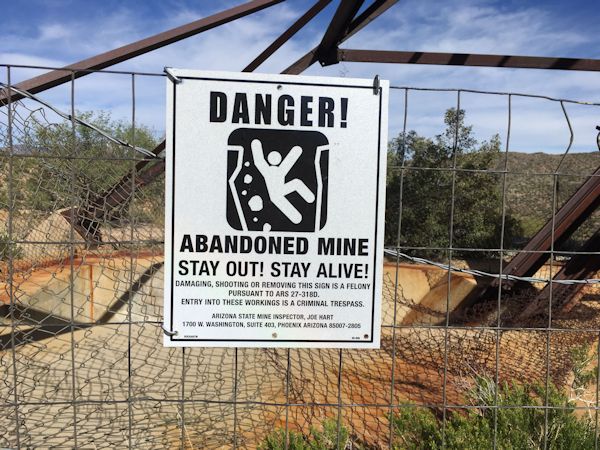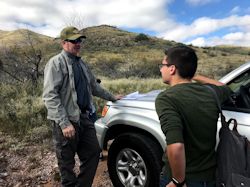SEJournal Online is the digital news magazine of the Society of Environmental Journalists. Learn more about SEJournal Online, including submission, subscription and advertising information.
 |
| Arizona has tens of thousands of abandoned mine sites that the author reports can represent a fatal danger to those who unwittingly wander nearby. Photo: Nicole Neri/Cronkite News. Click to enlarge. |
EJ Academy: The Journalism Student Who Went Down a Rabbit Hole and Came Up a Mine Shaft
By Chris McCrory
Five months of investigative reporting, countless hours of editing and thousands of words written on Arizona’s abandoned mines began with a simple task: Find a story.
In the fall semester of 2018, I was a returning student enrolled in Arizona PBS’s Cronkite News, the capstone project for a majority of the journalism students at Arizona State University. The program always starts with a training session and I was asked to give an example of the stories hidden in plain sight on government websites.
To find that example, I bounced around several government agency websites until, on the Arizona State Mine Inspector website, I saw a phrase, “Stay Out Stay Alive.” The campaign to warn the public about the dangers abounding on mine properties piqued my morbid curiosity.
One rabbit hole of searching later, I found the genesis of a story: the 11th annual letter from the state mine inspector begging for more abandoned mine funding.
From quick hit to long haul
Originally, the story was meant to be a quick turnaround, something to publish within a week or two. I assumed, based on the letter, that Mine Inspector Joe Hart would be more than willing to talk. Instead, he dodged multiple interview requests over five months.
 |
| Reporter Chris McCrory, right, interviews Arizona Game & Fish bat biologist Joel Diamond at an abandoned mine shaft. Photo: Nicole Neri/Cronkite News. Click to enlarge. |
While I waited, I began calling experts in different states to ask about how many mines were there and, in the process, learned the terminology. For instance, I learned that in most places, a “feature” was the definition for each hole, regardless of whether it was an entrance or an air shaft.
On paper, Nevada has more mine features than Arizona, but because they count each pile of rocks pulled from the ground as a feature, their numbers are overstated. Arizona has the highest number of holes in the ground, around 100,000.
By this point, I knew it was a bigger story than anybody had assumed, and I never let my editor forget it. Every morning when the environmental reporters in our program met, I gave an update on how my mine research was going before starting my pitches. I wouldn’t let it go. When you have a story like this, it tumbles around in your brain like a stone in a rock polisher.
Once I had secured my first interviews, with Mine Inspector Jerry Tyra and bat biologist Joel Diamond, fellow broadcast and photojournalists were roped into the assignment. In teams of three, we drove hundreds of miles to remote dirt roads where our sources waited. The photos and videos embedded in the resulting story ended up a huge part of what makes them so compelling.
Clippings track injuries and deaths
One of the biggest challenges in reporting the story was the lack of quality data. Because there isn’t a mandatory reporting policy for abandoned mines, the mine inspector’s office for decades used old newspaper clippings to catalog injuries and deaths.
Its database of mine locations only lists about 19,000. Even after fighting with the mine inspector’s office over public records for several months, we were only able to get hold of a redacted version that didn’t have the locations.
The incomplete records actually help
paint the picture — that this is
a giant problem that few people
even know, let alone care, about.
But the incomplete records actually help paint the picture — that this is a giant problem that few people even know, let alone care, about.
The biggest surprise, however, was the kind of people who did actually care, such as a club of older, retired men we spent a day in jeeps with, who just enjoyed riding through the rough terrain. One member of the Havasu 4 Wheelers Club almost drove his jeep into an abandoned mine near their riding trails, inspiring the group to fence similar mines.
Historians in Kingman, too, pored over hand-drawn maps of the nearby mountains to find the mines because they’re a part of the state’s history. They have hundreds of index cards and maps filed away in a records room in the back of one of the city’s museums.
Aiming for outrage
In a tiny ghost town near the state’s western border, the residents warned us against going near the mines because they still remembered how two girls fell into one a decade ago. The town’s general store, which looks like it came out of an old Western movie, is named the Mineshaft Market.
As I worked on reporting the story
I hoped maybe public outrage would
force a change in policy.
I hoped that then, and I’m still hoping now.
As I interviewed these people and dozens of others, I developed a personal interest in the story. Journalists want their work to make a change, and I’m no different. As I worked on reporting the story and writing it, I hoped it would be read by the right people and funding would come, or maybe public outrage would force a change in policy. I hoped that then, and I’m still hoping now.
Originally, the reporting was designed as a three-part series. I put in every fact, every voice and every piece of the story I had collected over months of on-the-ground reporting because I was fascinated by the subject and thought all of it was important. But when I handed it to my editors, they quickly realized what I had been too wrapped up in writing to realize: it was simply too long.
The editing process for this story was less about answering questions readers could have and more about trimming away the excess. The finished piece was around 5,100 words, split into two parts. Over two weeks, we had cut away a third of the finished reporting and found ways to fit the most important aspects inside the parts worth keeping.
Initially, I was afraid that condensing the writing that much would remove the sense of scale from the story. Instead, I found that the pieces contained even more impact because they hit readers one after another with no pause.
Despite lack of change, the reporting matters
After the Society of Environmental Journalists’ conference in Fort Collins, Colo., last October, I reached out again to my main contact at the Arizona State Mine Inspector’s office. I wanted to know if there had been any updates since I had published the story, because the 2019 state budget had been approved and proposals for the 2020 budget had been submitted.
Days later, I got a response: a resounding no. The state hadn’t increased their budget for the year after my story was published, and the office didn’t expect any increase for next year either. Nothing has changed.
But I’m still confident that the reporting matters. Eventually, I have no doubt that something will change. The state will have to face this issue at some point. Because I’m more convinced than ever that if Arizona doesn’t do anything, it’s only a matter of time until somebody dies again.
Chris McCrory is the weekend content manager and a digital reporter for WWL-TV in New Orleans. Before that, he covered crime, education and environmental issues with Cronkite News and served as news director for the KHTS Radio newsroom in California, leading coverage of wildfires and politics. He graduated from Arizona State University on Dec. 10, 2018, hours after the second part of his abandoned mines story was published.
* From the weekly news magazine SEJournal Online, Vol. 5, No. 2. Content from each new issue of SEJournal Online is available to the public via the SEJournal Online main page. Subscribe to the e-newsletter here. And see past issues of the SEJournal archived here.














 Advertisement
Advertisement 



